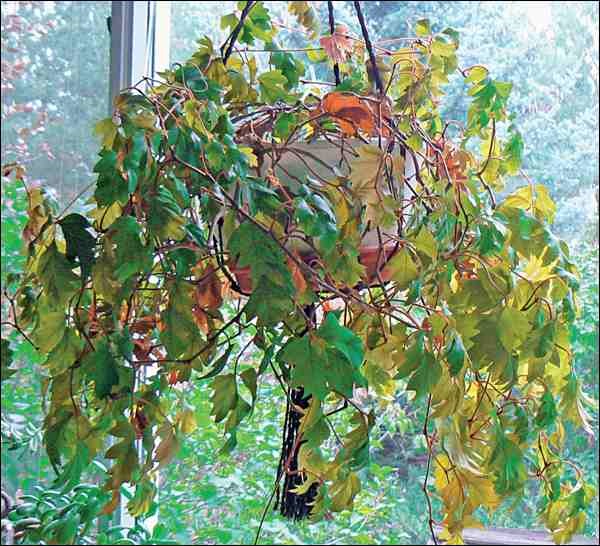Looking for a foliage houseplant that can pretty well survive without you? For longevity and ease of care - verging on downright neglect (I speak from experience) - grape ivy (Cissus rhombifolia) is hard to beat. Closely related to grapes, it can climb or trail and tolerates a wide range of conditions. My own plant is past its 25th birthday and has never been coddled.
Grape ivy has green, compound, tri-foliate leaves, each leaf composed of three leaflets about five centimetres long, grape-like in shape, and deeply lobed with toothed margins. New growth is covered in fine hairs, giving it a silvery appearance, while older leaves are a shiny green. Depending on the cultivar, plants may or may not have clinging tendrils able to curl around a support (or your Venetian blinds) and thus climb.
Although adaptable to a wide range of light intensities, most Cissus species perform best in bright indirect light. Too much exposure to bright sunlight can sometimes cause leaf discoloration that may at first resemble watermarks but later turn brown. They do best at cool room temperature (13 to 18 C). Water enough to ensure the media is thoroughly moistened, waiting until the top half has dried out before watering again. Mine have gone through a few periods of prolonged drought during which most of their leaves were shed, but they perked up and grew new ones once watering resumed. Fertilize with a complete water-soluble houseplant fertilizer according to label directions once a month.
As plants grow, they can be moved into the next larger pot size. But even large plants will seldom require more than a 25 centimetre pot. Once this size has been reached, top-dress them once a year with fresh potting mixture.
Propagation is easy. Simply take 15 centimetre tip cuttings of new spring growth. Remove the lower leaves, dip the cut ends into rooting powder, and insert into a well-draining, soil-less potting mix. Cover with a clear plastic bag with ventilation holes and set in indirect light. Once new growth appears, the cuttings have likely rooted and you can now remove the bag.
Like many tropical foliage plants, the genus Cissus gained popularity during Queen Victoria's time, and by the 1880s was in wide use as a parlour plant.
Other species include:
Cissus striata is a miniature version of grape ivy with thin reddish stems and bronzy-green, palmately compound leaves made up of five leaflets. New growth and the undersides of mature leaves are pink. Native to Chile and Brazil, it's ideal for hanging baskets.
Princess vine (C. sicyoides) is a vigorous species, needing more space than grape ivy. The large, heart-shaped leaves are 10 centimetres in length, slightly toothed and light green.
Sometimes called rex-begonia vine because of its resemblance to this unrelated species, C. discolor has lovely variegated leaves of green, pale purple and silver with an almost velvet-liked texture. Native to the humid tropical forests of Java, it is more finicky than other species, requiring bright light, slightly higher temperatures, increased humidity and regular irrigation.
Kangaroo ivy (C. antarctica) is a popular species, capable of reaching two to three metres in height and extremely tolerant of the dry atmosphere of our prairie homes. It's common name points to its home as Australia (not Antarctica as its Latin name suggests). The somewhat oval, leathery leaves are toothed, pointed and about 10 centimetres in length with red stalks. Regular pinching of the growing points gives it a bushier appearance. A dwarf form, Minima, is slower growing and often used in hanging baskets.
Sara Williams is the author of the new, revised and expanded Creating the Prairie Xeriscape as well as the Saskatoon Forestry Farm Park & Zoo: A Photographic History. She will be leading tours to Morocco, Turkey and Ireland in 2015. Call Ruth at 1-888-778-2378 (ruth@worldwideecotours.com) for information.
- This column is provided courtesy of the Saskatchewan Perennial Society (www.saskperennial.ca; hortscene@yahoo.com). Check out our Bulletin Board or Calendar for upcoming garden information sessions.



